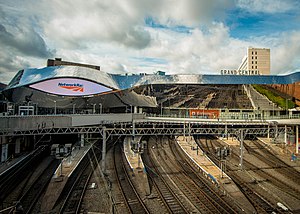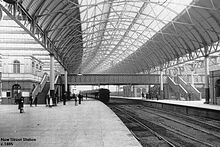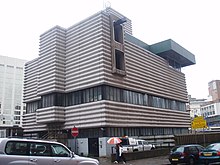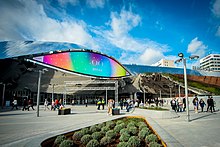
A | B | C | D | E | F | G | H | CH | I | J | K | L | M | N | O | P | Q | R | S | T | U | V | W | X | Y | Z | 0 | 1 | 2 | 3 | 4 | 5 | 6 | 7 | 8 | 9
 The east end of the station, with the newly rebuilt and refurbished building which opened in 2015. | |||||
| General information | |||||
| Location | Birmingham, West Midlands England | ||||
| Coordinates | 52°28′40″N 1°53′56″W / 52.47777°N 1.89885°W | ||||
| Grid reference | SP069866 | ||||
| Managed by | Network Rail | ||||
| Transit authority | Transport for West Midlands[1] | ||||
| Platforms | 13 (including 4C) | ||||
| Other information | |||||
| Station code | BHM | ||||
| Fare zone | 1 | ||||
| Classification | DfT category A | ||||
| History | |||||
| Original company | London & North Western Railway | ||||
| Key dates | |||||
| 1 June 1854 | First opened | ||||
| 8 February 1885 | Extension opened | ||||
| 1964–1967 | Rebuilt | ||||
| 2010–2015 | Redeveloped | ||||
| Passengers | |||||
| 2018/19 | |||||
| Interchange | | ||||
| 2019/20 | |||||
| Interchange | | ||||
| 2020/21 | |||||
| Interchange | | ||||
| 2021/22 | |||||
| Interchange | | ||||
| 2022/23 | |||||
| Interchange | | ||||
| |||||
| |||||
Birmingham New Street, also known as New Street station, is the largest and busiest of the three main railway stations in Birmingham city centre, England, and a central hub of the British railway system. It is a major destination for Avanti West Coast services from London Euston, Preston, Glasgow Central and Edinburgh Waverley and West Midlands Trains services from Liverpool Lime Street and London Euston both via the West Coast Main Line. The CrossCountry network centres on New Street, as well as local and suburban services within the West Midlands; these include those on the Cross-City Line between Lichfield Trent Valley, Redditch and Bromsgrove, and the Chase Line to Walsall and Rugeley Trent Valley. The three-letter station code is BHM.[2]
The station is named after New Street, which runs parallel to the station, although the station has never had a direct entrance from New Street except via the Grand Central shopping centre. Historically, the main entrance to the station was on Stephenson Street, just off New Street. As of 2022, the station has entrances on Stephenson Street, Smallbrook Queensway, Hill Street and Navigation Street.
New Street is the eleventh busiest railway station in the UK and the busiest outside London, with 30.7 million passenger entries and exits between April 2022 and March 2023. It is also the busiest interchange station outside London, with over 4 million passengers changing trains at the station annually. In 2018, New Street had a passenger satisfaction rating of 92%, the third highest in the UK.[3]
The original New Street station opened in 1854. At the time of its construction, the station had the largest single-span arched roof in the world.[4] In the 1960s, the station was completely rebuilt. An enclosed station, with buildings over most of its span and passenger numbers more than twice those it was designed for, the replacement was not popular with its users. A £550m redevelopment of the station named Gateway Plus opened in September 2015; it includes a new concourse, a new exterior facade and a new entrance on Stephenson Street.[5]
History
The first railway stations

New Street station was built in central Birmingham by the London and North Western Railway (LNWR) between 1846 and 1854, on the site of several streets in a marshy area known as "The Froggery"; it replaced several earlier rail termini on the outskirts of the centre, most notably Curzon Street, which had opened in 1838 and was no longer adequate for the level of traffic.[6] Samuel Carter, solicitor to both LNWR and the Midland Railway, managed the conveyancing.
The LNWR originally shared the station with the Midland Railway; however, in 1885, the Midland Railway opened its own extension alongside the original station for the exclusive use of its trains, effectively creating two stations side by side. The two companies' stations were separated by a central roadway, Queens Drive. [6] Traffic grew steadily and, by 1900, New Street had an average of 40 trains an hour departing and arriving, rising to 53 trains in the peak hours.[7]

Original LNWR station
| London and Birmingham Railway (New Street Station) Act 1846 | |
|---|---|
| Act of Parliament | |
 | |
| Long title | An Act for making a Railway from the London and Birmingham Railway to or near to Navigation Street within the Borough of Birmingham. |
| Citation | 9 & 10 Vict. c. ccclix |
| Dates | |
| Royal assent | 7 August 1846 |
| Text of statute as originally enacted | |

In 1846, the LNWR had obtained an act of Parliament (9 & 10 Vict. c. ccclix) to extend their line into the centre of Birmingham, which involved the acquisition of some 1.2 hectares (3 acres) of land and the demolition of around 70 houses in Peck Lane, The Froggery, Queen Street and Colmore Street.[8] The Countess of Huntingdon's Connexion chapel, on the corner of Peck Lane and Dudley Street, which had only been built six years before,[9] was also demolished.[10] The station was formally opened on 1 June 1854,[11] although the uncompleted station had already been in use for two years as a terminus for trains from the Stour Valley Line, which entered the station from the Wolverhampton direction. On the formal opening day, the LNWR's Curzon Street station was closed to regular passenger services and trains from the London direction started using New Street.[6]
The station was constructed by Messrs. Fox, Henderson & Co. and designed by Edward Alfred Cowper of that firm, who had previously worked on the design of the Crystal Palace. When completed, New Street had the largest arched single-span iron and glass roof in the world, spanning a width of 211 feet (64 m) and being 840 ft (256 m) long.[6][11] It held this title for 14 years until St Pancras station opened in 1868. It was originally intended to have three spans, supported by columns; however, it was soon realised that the supporting columns would severely restrict the workings of the railway. Cowper's single-span design, was therefore adopted, even though it was some 62 feet (19 metres) wider than the widest roof span at that time.[12][13] George Gilbert Scott praised Cowper's roof at New Street, stating "An iron roof in its most normal condition is too spider-like a structure to be handsome, but with a very little attention this defect is obviated. The most wonderful specimen, probably, is that at the great Birmingham Station…"[14] When first opened, New Street was described as the "Grand Central Station at Birmingham" by Richard Foster.[15]
The internal layout of tracks and platforms was designed by Robert Stephenson and his assistants; the station contained a total of nine platforms, comprising four through and five bay platforms.[6] The main entrance building on Stephenson Street incorporated Queens Hotel, designed by John William Livock, which was opened on the same day. It was built in an Italianate style and was originally provided with 60 rooms. The hotel was expanded several times over the years and reached its final form in 1917, with the addition of a new west wing.[11][16] The scale of the station at this time was documented in the station's entry in the 1863 edition of Bradshaw's Guide:[17]
The interior of this station deserves attention from its magnitude. The semicircular roof is 1,110 feet long, 205 feet wide and 80 feet high, composed of iron and glass, without the slightest support except that afforded by the pillars on either side. If the reader notices the turmoil and bustle created by the excitement of the arrival and departure of trains, the trampling of crowds of passengers, the transport of luggage, the ringing of bells and the noise of two or three hundred porters and workmen, he will retain a recollection of the extraordinary scene witnessed daily at Birmingham Central Railway Station.
The roof of the original station was strengthened with additional steel tie bars during 1906–07, as a precaution following the collapse of a similar roof which killed six people at Charing Cross station in 1905.[18]
-
The interior of the original LNWR station in the late 19th century, with its once record-breaking roof
-
Victorian image of the interior of the LNWR station
-
The main entrance building to the old station on Stephenson Street, incorporating Queens Hotel, c. 1920
-
The main entrance to the old station on Stephenson Street, including Queens Hotel in 1962
Midland Railway extension

Midland Railway trains that had used Curzon Street began to use New Street from 1854; however, its use by the Midland Railway was limited by the fact that those trains going between Derby and Bristol would have to reverse, so many trains bypassed New Street and ran through Camp Hill. This was remedied in 1885, when a new link to the south, the Birmingham West Suburban Railway, was extended into New Street, which allowed through trains to and from the south-west to run via New Street without reversing.[19]

To cope with the increase in traffic that this would bring, the station required an extension, the construction of which began in 1881. A number of buildings, mostly along Dudley Street, were demolished to make room for it, including a number of cottages, some business premises and a small church.[6] Built immediately to the south of the original station, the extension contained four through platforms and one bay.[20] It consisted of a trainshed with a glass and steel roof comprising two trussed arches, 58 ft (18 m) wide by 620 ft (189 m) long, and 67 ft 6 in (21 m) wide by 600 ft (183 m) long. It was designed by Francis Stevenson, chief engineer to the LNWR.[11] The extension was opened on 8 February 1885.[11] On completion, New Street had nearly doubled in size and became one of the largest stations in Britain, covering an area of over twelve acres (4.9 ha).[16]
In early 1885, the number of daily users of the station was surveyed. On a Thursday, the number was 22,452 and on a Saturday it was 25,334.[21]
Initially, the extension was used by both the LNWR and Midland Railway but, from 1889, it was only used by Midland Railway trains.[22] It was separated from the original LNWR trainshed by Queens Drive, which became a central carriageway, but the two were linked by a footbridge which ran over Queens Drive and across the entire width of both the LNWR and Midland stations.[23] Queens Drive was lost in the 1960s rebuild, but the name was later carried by a new driveway, which served the car park and a tower block, and is the access route for the station's taxis.
On 1 February 1910, the LNWR introduced a "City to City" service between New Street and Broad Street, in the City of London. The service only lasted for five years, before being withdrawn on 22 February 1915, as a result of the First World War.[24]
LMS and British Rail

In 1923, the LNWR and Midland Railway, with others, were grouped into the London, Midland and Scottish Railway (LMS) by the Railways Act 1921. In 1948, the railways were nationalised and came under the control of British Railways.
During the Second World War, Cowper's roof sustained extensive bomb damage as a result of air raids during the Birmingham Blitz. After the war, the remains of the roof were dismantled after being deemed beyond economic repair. It was replaced with austere canopies over the platforms, made from surplus war materials, which remained in use until the station was rebuilt in the 1960s.[25][26][6]
1960s rebuild
The station was completely rebuilt in the 1960s, as part of the modernisation programme for the West Coast Main Line. Demolition of the old station and Queens Hotel began in 1964 and was not completed until 1966.[27] The rebuilt New Street station was opened on 6 March 1967 to coincide with the introduction of electric expresses on the West Coast Main Line. It cost £4.5 million to build (equivalent to £103,170,000 in 2023).[28][29]

The new station was designed by Kenneth J. Davies, lead planner for British Rail London Midland Region.[30] Twelve through platforms replaced the eight through and six bay platforms of the previous station.[28] The platforms were covered over by a seven-acre (2.8 ha) concrete deck, supported by 200 columns, upon which the concourse and other buildings were constructed. Escalators, stairs and lifts were provided to reach the platforms from the concourse. The new station had sold its air rights, leading to the construction of the Pallasades Shopping Centre (then known as the Birmingham Shopping Centre) above the station between 1968 and 1970.[16][30][31] The public right of way across the station, which had previously been maintained by the station footbridge, was retained in the new station via a winding route through the shopping centre.[32] The station and the Pallasades were partly integrated with the Bullring Shopping Centre via elevated walkways above Smallbrook Queensway.
Also above the station was a nine-storey office block called Ladywood House,[33] and a multi-storey car park dating from the 1970s. The car park closed in May 2012; it was demolished to provide space for the new concourse and was rebuilt.[34] Stephenson Tower, a 20-storey residential tower block, was built alongside the station between 1965 and 1966.[35] The tower, designed by the City Architect of Birmingham, was demolished in March 2012 as part of the station redevelopment.[36]
In 1987, twelve different horse sculptures by Kevin Atherton, titled Iron Horse, were erected between New Street station and Wolverhampton at a cost of £12,000.[37][38] One stands on platform 7 at New Street.[39]
Due to its enclosed sub-surface platforms, New Street was designated as an underground station by the fire service. In the 1990s, a number of changes had to be made to the station in order to comply with stricter fire regulations, introduced for underground stations as a result of the 1987 King's Cross fire. In 1993, a new enclosed footbridge was opened at the Wolverhampton end of the station, with access to the platforms separate from the main building; this was built primarily as a fire exit, but the new exit from the station into Navigation Street was opened to the public. All wooden fittings were removed from the platforms and new fire doors were also installed at the foot of the stairs and elevators on the platforms.[32]
By the 2000s, the station was unpopular with its users. In a 2007 survey, it scored a customer satisfaction rate of only 52%, the joint lowest of any Network Rail major stations along with Liverpool Lime Street and East Croydon.[40] The station had become inadequate for the level of traffic with which it was dealing; it had been designed with capacity for 650 trains and 60,000 passengers per day. In 2008, there were 1,350 trains and over 120,000 passengers per day.[41][4] By 2013, it was 140,000 passengers per day.[42] This made overcrowding and closures on safety grounds more common.[43] Furthermore, the 1960s concrete architecture and enclosed design was widely criticised on aesthetic grounds.[44] In November 2003, the station was voted the second biggest "eyesore" in the UK by readers of Country Life magazine.[45] In books on railway station architecture, it was described by Steven Parissien as a "depressing underground bunker" and by Simon Jenkins as "hideous".[46]
-
The concrete external architecture of the 1960s station
-
The western end of the station
-
A Virgin Trains Pendolino waiting at platform 2 at New Street in 2009
-
The former station concourse at rush hour
-
Iron Horse sculpture

New Street signal box
The power signal box at New Street was completed in 1964 on the site of the former turntable, housing the Westpac Geographical Interlocking & Signalmens push button control panel (the largest relay interlocking in the world when installed) and also the Railway Telephone Exchange.[11] It is a brutalist building with corrugated concrete architecture, designed by John Bicknell and Paul Hamilton in collaboration with William Robert Headley, the regional architect for British Railways London Midland Region.[47] The eight-level structure with five main storeys, including track & street levels and cable chamber below track level, is at the side of the tracks connected to Navigation Street. As of 2020, it is a Grade II-listed building.[48][49] Until recently, two small sidings (nos. 2 & 3 Engine Sidings) were located in front of the signal box which were used for stabling electric locomotives in connection with locomotive changes from diesel to electric traction on XC services heading north. As they are no longer needed, these have now been removed in connection with the ongoing resignalling project for the station area. No. 1 Engine Siding was located at the north end, between platforms 4 and 5, and was lengthened some years ago to form platform 4C.
Don's Miniature New Street
A Sutton Coldfield model railway enthusiast, Don Jones, built a scale model of the entire 1960s station and surrounding buildings including the Rotunda, the old Head Post Office and the signal box, at OO scale; open days were held to raise funds for local charities.[50][51] Private visits were held for Robert Redford and King Hussein of Jordan and locomotive owner Jeremy Hosking visited whilst a pupil at Rugby School.[51]
2010–2015 redevelopment

As a result of the problems with the existing station, proposals to redevelop the station gained traction in the mid-2000s. A feasibility study was approved in January 2005. Designs were shown to the public in February 2006 for a new Birmingham New Street Station, in a project known as Gateway Plus.[52] A regeneration scheme was launched in 2006[53] and evolved through names such as Birmingham Gateway, Gateway Plus and New Street Gateway. The scheme proposed complete rebuilding of the street-level buildings and refurbishment of the platforms by 2013, with track and platform level remaining essentially unchanged.
The approved planning application of August 2006 showed a glass facade with rounded edges. The entrance on Station Street originally included two curved 130 metres (427 ft) tall towers on the site of Stephenson Tower. Due to the economic slowdown, the "twin towers" plan was shelved.[54]

In February 2008, the Secretary of State for Transport, Ruth Kelly, announced that the Department for Transport would provide £160 million in addition to £128 million through the government white paper Delivering a Sustainable Railway.[55] A further £100 million came from the Department for Business, Enterprise and Regulatory Reform and channelled through Advantage West Midlands, the regional development agency. The announcement brought total government spending on the project to £388 million.[56] After earlier proposals were discarded, six architects were shortlisted to design the new station following a call for submissions [57] and it was announced, in September 2008, that the design by Foreign Office Architects had been chosen.[58]

The approved plans for the redevelopment included:[59]
- A new concourse three-and-a-half times larger than the 1960s concourse, with a domed atrium at the centre to let in natural light.
- Refurbished platforms reached by new escalators and lifts.
- A new station facade and new entrances.
The fact that the proposed Gateway development would leave the railway capacity of the station more or less unaltered has not escaped attention. In July 2008, the House of Commons Transport Committee criticised the plans; it was not convinced they were adequate for the number of trains which could use the station. It said if the station could not be adapted, then the government needed to look for alternative solutions which potentially included a completely new station in the city.[60]
Work began on the redevelopment on 26 April 2010.[61] Construction was completed in phases to minimise disruption. On 28 April 2013, one half of the new concourse was opened to the public and the old 1960s concourse was closed for redevelopment, along with the old entrances.[62] The complete concourse opened on 20 September 2015, the Grand Central shopping centre four days later.[63][64] The refurbished Pallasades Shopping Centre was renamed Grand Central and included a John Lewis department store.[65] During heavy winds on 30 December 2015, several roof tiles blew off, landing in the adjacent Station Street, which was therefore closed by the police as a precautionary measure.[66]










